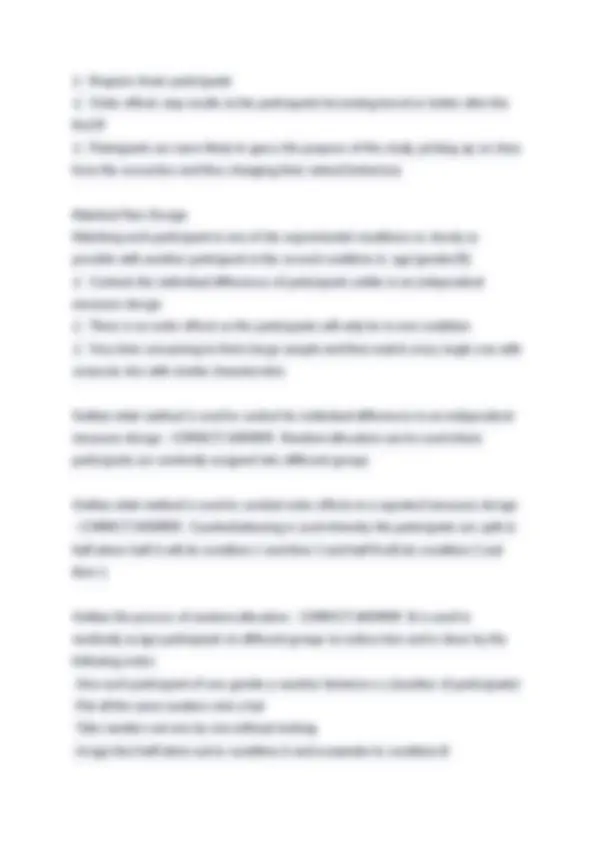










Study with the several resources on Docsity

Earn points by helping other students or get them with a premium plan


Prepare for your exams
Study with the several resources on Docsity

Earn points to download
Earn points by helping other students or get them with a premium plan
Community
Ask the community for help and clear up your study doubts
Discover the best universities in your country according to Docsity users
Free resources
Download our free guides on studying techniques, anxiety management strategies, and thesis advice from Docsity tutors
AQA A Level Psychology Research Methods complete AQA A Level Psychology Research Methods complete AQA A Level Psychology Research Methods complete AQA A Level Psychology Research Methods complete
Typology: Exams
1 / 14

This page cannot be seen from the preview
Don't miss anything!









Methods are what psychologists use to conduct their research. There are two areas of methods, what are these? - CORRECT ANSWER - Experimental Methods and Non- Experimental Methods Outline what experimental methods consist of - CORRECT ANSWER - Lab, natural, field and quasi experiments Outline what non-experimental methods consist of - CORRECT ANSWER - Correlational analysis, observations, case studies and self report (interviews and questionnaires) Outline a lab experiment and evaluate it - CORRECT ANSWER - Conducted within a lab which has high control over the environment. :) - High level of control over variables meaning that extraneous variables are likely to be controlled and thus a cause and effect relationship can be established between IV and DV :) - High reliability of results due to the tight control over variables meaning that it can be repeated and findings can be checked for consistency :( - It lacks ecological validity as it takes place in a very fake setting, with possibly a fake task, therefore making it hard to generalise the results to other environments or settings
:( - It can encourage demand characteristics as participants know they are being watched/recorded and thus they change their behaviour based on clues on what the aim is, to suit what the researcher wants to see, this affects the accuracy of the results Outline a field experiment and evaluate it - CORRECT ANSWER - Takes place in a real environment such as a school, and there is then an IV that is manipulated to effect the DV. :) - Less prone to demand characteristics as people may not know they are taking part is an experiment and thus will display natural behaviour :) - High ecological validity as the setting is real life meaning the findings can then be generalised to other settings beyond the study :( - It lacks reliability in the findings as it is done in a setting where there is little control over confounding variables meaning it is difficult to replicate it and get consistency in results :( - Ethical issues can arise when conducting a field experiment as people are not aware they are taking part and thus there is no informed consent that they are giving to be able to study them, therefore there is risk that the participants will not want their results used and thus must be removed Outline a natural experiment and evaluate it - CORRECT ANSWER - In a real setting with a naturally occurring IV, for example looking at the effect of stress after an earthquake hits a city. :) - Participants show no demand characteristics at all as at the time of the IV occurring they did not know about the study as this will show natural behaviour :) - Very high ecological validity as it is set in a real environment and nothing is controlled, so therefore you are able to generalise the findings beyond the setting of the study :( - It lacks reliability as there is zero control over variables meaning that it is difficult to replicate the experiment and get consistent results :( - Due to the lack of control over extraneous variables it is very difficult to establish a cause and effect relationship and thus this reduces the internal validity
:( - Ethical issues can arise as people are not aware they are taking part and thus there is no informed consent that they are giving to be able to study them, therefore there is risk that the participants will not want their results used and thus must be removed Overt observation - Participants are aware they are being observed :) - This avoids ethical issues arising :( - It can encourage demand characteristics as participants know they are being watched/recorded and thus they change their behaviour based on clues on what the aim is, to suit what the researcher wants to see, this affects the accuracy of the results Participan Outline what an interview is and what types of interviews there are and evaluate each
Unstructured interview - May contain a topic area for discussion but no set questions. Provides highly detailed data but is hard to analyse :) - Effective for when the interview can adapt the questions based on the answers :( - More affected by interviewer bias as the interviewer will be coming up with questions on the spot which may be less objective/leading Outline what a questionnaire is and evaluate it - CORRECT ANSWER - Questionnaires form part of surveys which involve asking a large sample of people a series of questions to collect information on a particular topic :) - Participants can remain anonymous and this therefore means they are less likely to lie thus allowing psychologists to gain an insight into more sensitive topics :) - Can easily be repeated and distributed this can gain a large sample of people quickly and cheaply allowing for results to be more accurately generalised :( - Social desirability :( - Misinterpretation from both sides where the participants may answer the question wrong or the researcher may understand what the participants answer is Outline what a case study is and evaluate it - CORRECT ANSWER - It is an in depth study conducted into one small group or person. They can be over a long period of time and are often used alongside other techniques :) - Has high ecological validity as the environment is real therefore you can generalise the findings beyond the setting :) - As case studies use a large variety of techniques to collect data the data they collect is in depth qualitative data that provides rich information into the insight of the behaviour :( - Lacks population validity as it is usually only done on one person or a small group of people with unique characteristics and thus is difficult to generalise to the rest of the population :( - Often the data collected is retrospective about past events meaning that evidence required to make full conclusions may be missing or incorrect
Outline what investigator effects are and the three main types - CORRECT ANSWER - This results from the effects of the researchers behaviour on an investigation causing participants to act differently Experimenter Bias Every researcher has an expectation of what they expect to find and thus they may unconsciously influence the situation via body language/facial expressions Observer Bias Just the presence of an observer being there can cause participants to behave in a different manner to normal Interviewer Bias When carrying out an interview the presence of the interviewer may influence the participants response Outline and evaluate the three experimental designs - CORRECT ANSWER - Independent Measures Design This is where different participants take part in each condition of the IV ie. one group drinks redbull one group doesn't :) - There will be no order effects :) - It can be used when repeated measures design is inappropriate :( - Errors may occur due to the individual differences not being controlled which could then act as confounding variables and ruin the results gained, reducing internal validity :( - You need more participants unlike repeated measures Repeated Measures Design In this design every participant will take part in every condition of the IV :) - Individual differences between participants are removed as potential confounding variables
:) - Requires fewer participants :( - Order effects may results in the participants becoming bored or better after the first IV :( - Participants are more likely to guess the purpose of the study, picking up on clues from the researcher and thus changing their natural behaviour Matched Pairs Design Matching each participant in one of the experimental conditions as closely as possible with another participant in the second condition ie. age/gender/IQ :) - Controls the individual differences of participants unlike in an independent measures design :) - There is no order effects as the participants will only be in one condition :( - Very time consuming to find a large sample and then match every single one with someone else with similar charactersitics Outline what method is used to control for individual differences in an independent measures design - CORRECT ANSWER - Random allocation can be used where participants are randomly assigned into different groups Outline what method is used to combat order effects in a repeated measures design
Systematic sampling - a more technical approach to sampling where for example every Nth person may be taken :) - It is a simple method that allows there to be no researcher bias as they have no influence on who is chosen :( - Again it is time consuming getting all the target population Stratified sampling - different subgroups within the target population are identified then people from each subgroup are selected randomly in proportion to the size compared to the whole target population :) - Extremely representative as everyone has an equal chance of being selected Outline the issues of bias in sampling - CORRECT ANSWER - People can refuse to participate - this effects the type of person that you now have in your sample as it will only be a certain type thus lowering the population validity making it hard to generalise Minority subgroups overlooked - Some groups may be missed when choosing a sample this therefore means the results will not accurately represent the whole target population Certain target population targeted more - this can lead to an over representation of a certain group Sample size - if the sample is too small then again it can lead to a lack in population validity Outline the five key issues that arise when designing observations - CORRECT ANSWER - 1) Development of behaviour categories
i) Time interval sampling where you observe and record what happens in a fixed time ie. every 10 mins ii) Time point sampling where you observe a behaviour that occurs at a series of given times ie. meal times iii) Event sampling where you look at the complete event
Protection of participants - Right to withdraw + Right to help afterwards including doctors Confidentiality Outline the two methods for analysing qualitative data - CORRECT ANSWER - Content Analysis - this is where researchers change the qualitative data into quantitative data making it easier to analyse, it is done in the following way:
Ordinal Data - this is where data is ranked in order Interval/Ratio Data - the most sophisticated level of data whereby it not only gives the rank of scores in order but also details the precise intervals between scores Which chart would be used for each level of data - CORRECT ANSWER - Nominal Data - Bar charts as this data is discontinuous Ordinal Data - Frequency polygons as this is continuous Interval Data - This can be either a histogram or a frequency polygon